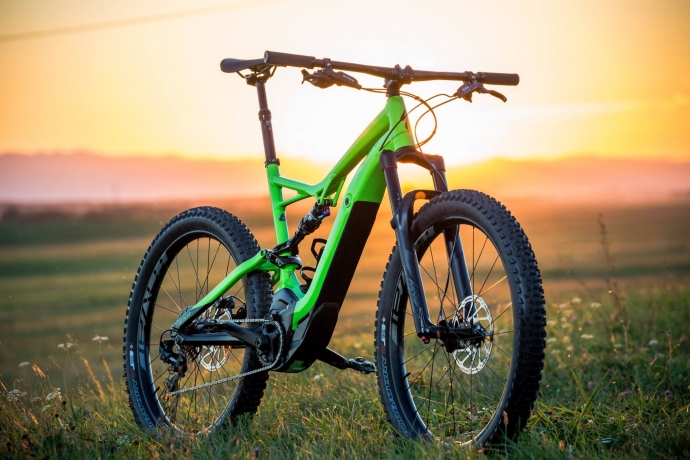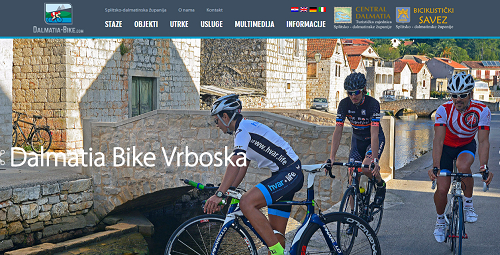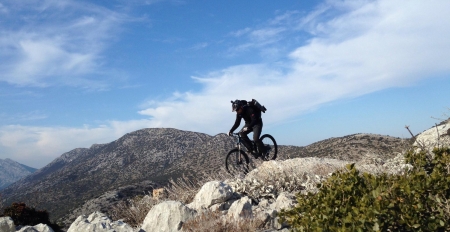Story and photos by Andrej Čubra
Specialized has always fascinated me as a brand. Technological details polished to the maximum and constant advancements on existing technologies as well as experimenting with something new, have brought this brand to the very Olympus of cycling producers. Stumpjumper was the first mass-produced MTB in the world! Epic was their full suspension and the first 29-incher to conquer world cups and is today one of the most numerous models at all competitions around the world. In the last years I have drive and owned a heap of Specialized models and I can say their geometries always thrill me anew and it’s a brand that I will surely stay loyal to in the coming years.
Here we have a full suspension bicycle with assisted pedalling. The bicycle does not offer the option of motorised movement but during pedalling aids in a certain percent up to a maximum 250 watts to your invested energy. What does that really mean? The average trained cyclist enthusiast who trains several times per week has an average of 200 watts of strength that can be maintained for a longer time. The Levo itself in its strongest mode adds another 250 watts to your watts! A professional cyclist in the world cup delivers on average around 400 watts. Considering the Levo is heavier, even the average cyclists can have the same ratio of power, which is impressive! According to legal norms, assistance stops when you pass 25 km/h and from there you are left on your own.
Specialized hesitated to enter the world of MTB assisted pedalling, but with the arrival of Levo, we see why. While others made freaky bikes, very long chain stays and disparately composed batteries, with large control screens (which in case of a fall can be a significant expense) and other elements which took them far from their normal models, Specialized thought about how to make an assistance bike which neither in form nor performance differs greatly from its brothers, driven by leg strength only. At the end of 2015, the Levo FSR hit the market, a bike that immediately overshadowed all competing bicycles of mass production. The geometry was almost identical to the Stumpjumper FSR model, with short chain stays and integrated battery in the downtube and elegantly solved engine cover, it did not differ much from a regular FSR. The frame itself is made from M5 premium aluminium, Specialized’s strongest and best choice with such a robust bicycle. Large screens were avoided by Specialized, with the basic controls positioned on the downtube with 10 LED lamps that each represent 10% of power and with 3 buttons, one to turn it on and the other two to change the level of assistance, factory predefined in 3 degrees - Eco (20% power), Trail (50%) and Turbo (100%). Very simple and effective and the view from the seat does not seem like it’s a different bicycle. Naturally, Specialized made a smartphone app, Mission Control App, in which you can change characteristics into details as well as the level of assistance in each mode, the reaction of the engine to pedal pressure and acceleration itself so the Levo can be adjusted to your needs. Do you want an eruption of supernatural power? Maybe you want the feeling of a normal bike, just with your legs “stronger?” It’s all possible here. It has an option via smartphone to monitor your ride like a GPS and automatically synchronize it with Strava and even choose the length of desired ride, leaving the choice of assistance to the application which will calculate how much assistance you need to safely drive the desired route. Specialized also decided to make use of the 27.5+ format of tires which represent an ideal choice on such a bicycle to take advantage of all bike options inhte sense of increased speed and needed traction.
While others decided to use Bosch and Yamaha motors, Specialized tested all available on the market and chose the German producer Brose which made an engine to their input, characterised by a huge torque of 90Nm, largest in class with nearly completely silent operation. A very look at the lines of Levo leave me breathless and I feel it is the first completely thought through and genially designed assistance bike. I guarantee that in the next few years all producers will begin to copy such design to achieve this complex yet genial simplicity the Levo offers. The Levo model I am testing here is the Comp for 2017, a level of accessories that represents the best value for money. Sram GX 1x11 group and Sram Guide R four piston brakes with 200mm rotors in the front and back and superior Rock Shox Yari 140mm gait fork with 35mm legs, essentially the same as the Pike model but with a different damper that offers less adjustment, but is simpler to adjust, at the same time with tokens that can be placed in the fork to get a more or less progressive feeling. Back end control is taken over by 135mm gait and Fox Float Performance DPS shock with autosag function, with the Levo equipped with a dropper post and the newest Specialized Command Post Ircc in 12 positions with 125mm gait in XL size frame, while the new dropper handle thrilled me, identical to the shifter and on the left side of the wheel, with handling easy as child’s play.
Why is the Comp the most desirable model? It offers everything necessary for the bike to operate perfectly. What I like about Specialized is that they stand behind their products and guarantee that for at least the next five years the battery design will not change, which means your Levo will not grow old suddenly but can be upgraded with a new battery of same dimensions. But let’s get to the point - how does this thing ride!
In one word, incredible! I was personally always opposed to any pedalling except the human kind. I felt these bikes were driven by weaklings and people who don’t understand the point of cycling. Until I tried it... Technologies are advancing and I must admit the Levo thrilled me after the first ride. Forget about sitting down and crossing Sljeme in half an hour. Not true at all. It’s just you, stronger than ever! In the Control App I chose the lowest acceleration and pedal sensitivity, with the feeling initially less impressive but much more fluid and more like classic pedalling. You try and push and there’s a huge force pushing you along additionally. This is my first experience with plus tyres in 27.5 3.0 variant and I can say they excited me! The level of grip compared to the classic 29 2.25 tyres is unreal, whether on ascents or descents. Higher speeds are possible, later braking, technical ascents usually undriveable open with new possibilities, especially combined with the electromotor. The tyres need just 1.1-1.2 bar to my larger constitution and a huge amount of vibrations is filtered while the tyres are much less sensitive to the surface.
On narrow trails and single trails there is more upper body work required and the bike is not as agile as an ordinary trail bike but it was not a problem for me. In fact, the extra mass gave me a sense of additional security on fast sections. Smaller and lighter drivers may have a different view of the situation. Levo performs best on open descents where with incredible speed and great safety it shoots along. On XC hard trails where I’m at my 90% and every moment difficult, on the Levo you have the feeling you’re at a third of your strength and faster!
Phenomenal geometry and fat, soft tyres offer a sense of invincibility! Imagine riding an axe, not too much squirming, just aim and Levo crosses everything, like a Big Foot! Speeds on Dalmatian rocks and loose gravel can be amazing considering you don’t have a feeling of being out of control or near the edge. Technical ascents are a joke as traction is always there and all you have to do is pedal and trust in the might and support of Levo.
How much does one strain or rest while riding the Levo? I have an example. I drove my standard ascent to Sljeme from Lonjščina to Stara Lugarnica over Leustek at 50% assistance. Compared to the light carbon HT 29, I reduced my ride time by 10-11 minutes and my maximum pulse was 177 beats and average 158. Without assistance I had an average pulse between 170-175 and my maximum was over 185! It means I wasn’t just sitting but I was below the area where I would lactate and produce acids. I arrived to the top completely wet but not drained as before. At the Transdinara marathon 2016 I followed the race as a press member and the marathon average 135 beats and 169 maximum! Around 20-25 beats lower than marathon average which is enough to have after 5-6-7 hours enough energy for other things without being depleted. The goal of this bike is to spend less time on ascents and cover more distance of serious terrain at the same time. You have little time but would love to ride your favourite route? You are weaker than your friends but would love to go with them to an epic ride? You have an injury you are recovering from but would love to enjoy trails with less burden or would love for your loved one to cross terrain they might find tough?
Levo has a solution for many scenarios and the only tough factor is the length of the route. Specialized is not all mighty here and is dependent on the current development and technology of batteries, but it still offers a lot. Total range is dependent on many factors. How many climbs, your weight, terrain and level of assistance you use are the main elements of the formula for the length of the route. At 20% power, Levo pushed at the standard 460Wh battery my 105 kg and another 10 kg of gear for 44 km and 1.340 metres ascent, with a very fast tempo and on demanding terrain. Lighter drivers of 75 kg in normal conditions can cover up to 80 km of mixed terrain. And you can always have a spare battery.
I had a problematic moment, the only one with the Levo, after a series of hard bumps the plug for the speed sensor semi-detached, with the motor not functioning without that reading. It’s a problem fixed in 2 minutes but I didn’t know this at the moment. Personally, I varied between 20 and 50% assistance, didn’t need any more. It’s great that you are constantly pedalling as you don’t want to lose assistance and the great weight of the Levo demands greater strength so all together it’s a great training for the whole body. You can even be as tired as on a regular bike and have an equally high pulse and you’ll cover more terrain in 2 hours. There are enormous possibilities with the Levo technology, with the bike especially fun to ride and instilling great trust.
Specialized has once again made a revolution and competition will have to try real hard to reach this level of intelligence and simplicity. A bicycle that offers a supernatural ride sensation and is capable of covering many scenarios might be attractive to many. Some as the only bike, some as the N+1 variant. Many friends, hardcore cyclists have looked down on the Levo, but all who tried it came back with a smile and concluded they’d love to play with it. I was personally thrilled with the possibilities and feel it can offer a lot to the trained cyclist, such as a machine to scout new trails, one to cover your favourite track faster if you don’t have time or a great press machine to follow the race with, have the complete feeling of the track and terrain with enough time to stop and take a photo without losing the competitors. A bunch of scenarios make sense with this bike and only your imagination is the limit! As riding bikes doesn’t always have to be furious pushing of one’s limitations but should sometimes be relaxing and fun and I don’t remember the last time I had as much fun as with Specialized Turbo Levo!
You can follow Andrej Čubra on Facebook / Story and photos by Andrej Čubra









